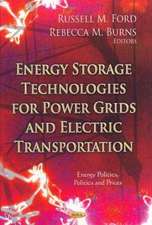An Introduction to Communication Theory and Systems: Springer Texts in Electrical Engineering
Autor John B. Thomasen Limba Engleză Paperback – 8 dec 1987
Preț: 391.99 lei
Nou
Puncte Express: 588
Preț estimativ în valută:
75.00€ • 78.32$ • 61.94£
75.00€ • 78.32$ • 61.94£
Carte tipărită la comandă
Livrare economică 15-29 aprilie
Preluare comenzi: 021 569.72.76
Specificații
ISBN-13: 9780387966724
ISBN-10: 0387966722
Pagini: 349
Ilustrații: XI, 349 p.
Dimensiuni: 155 x 235 x 19 mm
Greutate: 0.51 kg
Ediția:Softcover reprint of the original 1st ed. 1988
Editura: Springer
Colecția Springer
Seria Springer Texts in Electrical Engineering
Locul publicării:New York, NY, United States
ISBN-10: 0387966722
Pagini: 349
Ilustrații: XI, 349 p.
Dimensiuni: 155 x 235 x 19 mm
Greutate: 0.51 kg
Ediția:Softcover reprint of the original 1st ed. 1988
Editura: Springer
Colecția Springer
Seria Springer Texts in Electrical Engineering
Locul publicării:New York, NY, United States
Public țintă
ResearchCuprins
1-Introduction.- 1.1-Communication Systems.- 1.2-Statistical Communication Theory.- 1.3-Additional Reading.- 2-Probability and Random Variables.- 2.1-Introductory Remarks.- 2.2-Elements of Set Theory.- 2.3-A Classical Concept of Probability.- 2.4-Elements of Combinatorial Analysis.- 2.5-The Axiomatic Foundation of Probability Theory.- 2.6-Finite Sample Spaces.- 2.7-Fields,?-Fields, and Infinite Sample Spaces.- 2.8-Independence.- 2.9-Random Variables, Discrete and Continuous.- 2.10-Distribution Functions and Densities.- 2.11-The Transformation of Random Variables.- 2.12-Expectation.- 2.13-Moments.- 2.14-The Chebychev Inequality.- 2.15-Generating Functions.- 2.16-The Binomial Distribution.- 2.17- The Poisson Distribution.- 2.18- The Normal or Gaussian Distribution.- 2.19- Limit Theorems.- 2.20- Bivariate Distributions.- 2.21- The Bivariate Normal Distribution.- 2.22- The Multivariate Normal Distribution.- 2.23- Linear Transformations on Normal Random Variables.- Problems.- References.- 3-Random Processes and Spectral Analysis.- 3.1- Definition.- 3.2- Stationarity.- 3.3- Correlation Functions.- 3.4- Time Averages and Ergodicity.- 3.5- Convergence of Random Variables.- 3.6- Fourier Transforms.- 3.7- Integrals of Random Processes.- 3.8- Power Spectra.- 3.9- Shot Noise.- 3.10- Random Events in Time.- 3.11- The Mean and Autocorrelation Function of Shot Noise.- 3.12- The Amplitude Distribution of Shot Noise.- Problems.- References.- 4-Linear Filtering of Stationary Processes:Steady-State Analysis.- 4.1-Introduction.- 4.2-Discrete-Time Filters.- 4.3-Continuous-Time Filters.- 4.4-Complete Statistical Description of the Output of a Linear System.- 4.5-The Orthogonal Decomposition of Random Processes; Fourier Series.- 4.6-The Karhunen-Loeve Expansion.- 4.7-Optimal Truncation Properties of the Karhunen-Loeve Expansion.- 4.8-The Sampling Theorem.- 4.9-Narrow-Band Systems.- 4.10-Narrow-Band Systems with Added Sinusoids.- Problems.- References.- 5-Optimum Linear Systems: Steady-State Synthesis.- 5.1-Introduction.- I -The Matched Filter For Continuous-Time Inputs.- 5.2-Derivation.- 5.3-The Unrealizable Matched Filter in Continuous Time.- 5.4-Spectral Factorization for Continuous-Parameter Random Processes.- 5.5-Solution of the Integral Equation for the Continuous- Time Matched Filter.- II -The Matched Filter for Discrete-Time Inputs.- 5.6-Derivation.- 5.7-The Unrealizable Matched Filter in Discrete Time.- 5.8-Spectral Factorization for Discrete-Parameter Random Processes.- 5.9-Solution of the Integral Equation for the Discrete-Time Matched Filter.- III -The Linear Least-Mean-Squared-Error Filter for Continuous-Time Inputs.- 5.10-Formulation of the LLMSE Filtering and Prediction Problem in Continuous Time.- 5.11-The Unrealizable LLMSE Filter in Continuous Time.- 5.12-Solution of the Integral Equation for the Continuous- Time LLMSE Filter.- 5.13-The Mean-Squared Error for the Continuous-Time Case.- 5.14-The Pure Prediction Problem for the Continuous-Time Case.- IV-The Linear Least-Mean-Squared-Error Filter for Discrete-Time Inputs.- 5.15-Formulation of the LLMSE Filtering and Prediction Problem in Discrete Time.- 5.16-The Unrealizable LLMSE Filter in Discrete Time.- 5.17-Solution of the Integral Equation for the Discrete-Time LLMSE Filter.- 5.18-The Mean-Squared Error for the Discrete-Time Case.- 5.19-The Pure Prediction Problem for the Discrete-Time Case.- Problems.- Appendices.- Appendix A -The Riemann-Stieltjes Integral.- Appendix B -The Dirac Delta Function.- Appendix C -The Transformation of Coordinates.- Appendix D -Fourier Series and the Fourier and Laplace Transforms.- Appendix E -Some Inequalities Including Schwarz’s Inequality.- Appendix F -The Calculus of Variations.- Table-The Unit Normal Distribution.





















